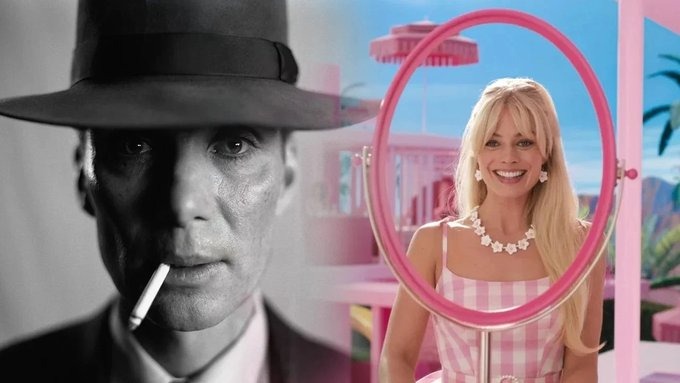Take the nuclear scare from “Oppenheimer” and cross it with the aesthetic of “Barbie” – and build more bridges between the two summer box office hits. Now you have Wes Anderson’s “Asteroid City!” Now you can get the stylish tragicomedy in your home theater.
This summer, anyone who was anyone celebrated the diversity of cinema with two contrasting (yet delightfully complementary) films: “Barbie” and “Oppenheimer” came out on the same day, giving us the extraordinary double feature “Barbenheimer.”
But why settle for two films when there’s a perfect contender to make a well-rounded, coherent triple feature? As of this week, the stylish tragicomedy “Asteroid City” is available in home theaters – making it the ideal link between “Barbie” and “Oppenheimer”:
Alternatively, you can buy the movie as VOD from Amazon Prime Video* – also in 4K!
“ASTEROID CITY”: THIS IS ANDERSON’S NEW STAR PARADE …
The desert town of Asteroid City, mid-1950s: kids gather to participate in the Junior Stargazer program – and some bring their parents. While the little ones outdo each other with dreams of the future, the adults give vent to repressed feelings. When an unforeseen event shakes up Asteroid City, the tranquil town becomes a military exclusion zone – with chaotic consequences….
The huge ensemble cast includes Jason Schwartzman as a grieving widower, Scarlett Johansson as an actress who turns a blind eye to him, Tom Hanks as a distant grandfather, Steve Carell as a motel owner and Maya Hawke as a teacher.
Other roles are taken by Sophia Lillis, Jeffrey Wright, Tilda Swinton, Adrien Brody, Bryan Cranston, Liev Schreiber and Edward Norton. And in a strong cameo, a major “Barbenheimer” personality drops by as well!
.. THIS IS WHAT SHE HAS IN COMMON WITH “BARBIE”…
In her billion-dollar success “Barbie,” director Greta Gerwig depicts a doll playset world packed with playful details in shades of pink and sky blue. Visually, “Asteroid City” is an impeccable complement to that style, showing us Wes Anderson’s childlike vision of the U.S. Southwest, which he (much like Gerwig) bathes in a nostalgia too clinical and innocuous to be true.
Dua Lipa talking about “Dance The Night” at AFI Fest! Barbie (via @NikkiFowler28) pic.twitter.com/uIsFdNAdzL
– Dua Lipa News (Fan Account) (@dlipanews) October 28, 2023
Although Wes Anderson doesn’t take apart outdated notions of gender roles as concretely as Gerwig, he too questions what societal expectations catch up with men and women. The inability to effectively show, let alone verbalize, negative emotions also plagues several “Asteroid City” characters, which is unmistakably interpreted as an effect of their environment.
And, much like “Barbie,” it’s over-the-top absurdist dialogue, tongue-in-cheek slapstick and surprisingly vulnerable monologues with which “Asteroid City” works through these issues.
.. AND THAT’S WHAT UNITES IT WITH “OPPENHEIMER”!
Christopher Nolan’s drama spans two narrative perspectives: one presented in color, the other in black and white. “Asteroid City” is also divided into a colorful and a black-and-white plane, even though it is about a frame and an internal plot. The fact that most of the film takes place in a militarily sealed desert city, similar to the nuclear research city Los Alamos from “Oppenheimer”, would be the icing on the cake …
… if it weren’t for the thematic connections! Nolan’s film sketches how a naive enthusiasm for nuclear research suddenly turns into fear about its seemingly endless, fatal consequences. “Asteroid City,” meanwhile, captures the (U.S.) attitude toward life during the turnaround.
The film’s main setting is a stone’s throw away from a nuclear test site, which doesn’t seem to worry anyone. But the frantic reactions to a previously unimaginable event and the slowly swelling fears in the characters foreshadow the era of constant nuclear anxiety. Meanwhile, the military’s paranoia about data leaks mirrors the present fear of communist moles from “Oppenheimer. “
“BARBENHEIMER CITY”: HERE’S HOW THE TRIPLE FEATURE GOES
“Asteroid City” virtually shows the reality created by Oppenheimer, filtered through a worldview that resembles “Barbie.” Beyond that, a thematic thread runs through the films: they reflect, incidentally yet unmistakably, how the romanticized notion of the Wild West seeped into the consciousness of (not only) the United States – and led to harmful male (self-)images.
This includes Oppenheimer’s self-image as a daring cowboy of physics, including his desire to be the pseudo-sheriff of his own Western town. As well as the simplifying Western deco-kitsch in “Asteroid City”. And finally Ken’s horse-loving macho attitude inspired, among other things, by pathetic images of the US Southwest.
If it’s up to the author of these lines, the ideal “Barbenheimer City” triple feature therefore begins with “Oppenheimer”. Second up is “Asteroid City,” which provides an opportunity to subconsciously brood over the themes of Nolan’s success. Plus, Anderson’s look back at the U.S. of the 1950s lets you see how the chain reaction set in motion beforehand affects society, while simultaneously tuning in to the “Barbie” bustle.
Gerwig’s “Barbie” consistently closes out the triple feature by totally turning up previously playfully executed, vehemently questioned childhood nostalgia. Moreover, over the course of the triple, the intellectual, overall political weltschmerz from “Oppenheimer” morphs into a personal, emotional weltschmerz. By means of musical interludes and fluffy sweaters, so that you can fall asleep comfortably after this movie marathon, instead of staring black holes into your bedroom ceiling.

